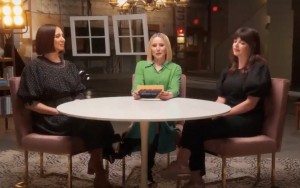As a doula and a midwife, explaining my profession to people is sometimes difficult. My automatic answer is, “I help deliver babies!” This usually scares people off or intrigues them enough to ask more questions. I want to strike a balance between educating people about the kind of gentle, supportive births I know doulas and midwives make possible and overloading them with too much information. Birth workers have a reputation as hippies, witches, and medicine women, which is often negative. And it is not indicative of the very professional and important work that we do.
What Is Birth?
I’ve always known I wanted to be a midwife. That’s not the kind of answer people expect a high school girl to give: “What do you want to be when you grow up?” I grew up surrounded by the same birth stories that American women are hearing, mostly from their friends, mothers, movies, and television shows. According to these sources, birth is scary and dangerous. It often doesn’t go according to plan. You are alone with your partner, expected to rush to the hospital as your water breaks, screaming in pain.
In college, I set out to investigate typical American births. It used to be that birth was a community experience. By the time you were ready to have a baby, you would have been present at a family member’s birth. Instead of walking into the hospital with little knowledge of what is about to happen, you would have been at home surrounded by supportive friends and family. But those days have long passed. Now, American women are unsure what to expect when it’s their turn to give birth.
This Is Birth.
Modern American women learn these stories through media, typically without being present for a live birth. We watch televised births and dramatized movies of emergency cesarean sections and episiotomies. In my academic work, I analyzed documentary films trying to tell a different story. Mass media is focused on what is (supposedly) happening in the hospital. Meanwhile, a whole genre of documentary films gives the viewer access to birth differently.
The Rise of Birth Documentaries.
The Business of Being Born (2008), produced by celebrity Ricki Lake, is by far the most popular of these.1 Joining the ranks of these films is Lisa Ling’s online journalistic series This is Birth.
Ling tackles subjects from cesarean sections to home births and surrogacy to fertility treatments. Ling’s online series compiles video footage and articles to paint a portrait of American pregnancy and childbirth in 2016.
Ling recorded these tapes and worked on the series leading up to her second birth. She had already planned a second cesarean section. In the film, she turns a critical eye to the medical system as a business and institution and speaks to countless experts about the benefits of vaginal delivery. However, Ling ultimately continues with her choice of a second elective cesarean. Unfortunately, upon being discharged after the birth of her second daughter, Ling developed an infection. This, combined with the difficult recovery from a second surgery, led her to write the article accompanying her first video, “Why I Regret My Scheduled C-Section.”
The Troublesome Rise of C-Sections.
By far the most personal segment of the series, Ling’s reporting on C-sections touches on the significance of birth experiences for women: “It is a leap of faith.” Birth is a deeply personal experience that initiates a woman into motherhood. Many women reflect on their birth experiences and are fuzzy on the details. But they never forget how the experience of giving birth made them feel.
Far from critiquing the birth choices of individual women, Ling dives into the systems behind the rising cesarean section rates in the United States. The matrix of hospital business models, insurance reimbursement policies, convenience and efficiency of modern surgery, and the medical training that obstetricians receive intertwine to create the 32% cesarean rate we have seen in the United States since 2009.2 This is well above the 10-15% rate recommended by the World Health Organization.3
Expanding from her own experiences, Ling explores the options available for American women today. Both professionals and other mothers alike constantly critique our choices. You can choose to freeze your eggs, have your baby at home, or use a surrogate. No matter your choice, someone will have something to say about how you are building your family.
A Voice for Alternative Birth Experiences.
Ling uses her voice as a celebrity journalist to put faces and names behind the stories of women doing things differently. Some giving birth with Certified Professional Midwives. Others choosing to delay motherhood and utilize modern technology. And others are finding alternative routes to conceiving a child. Her compelling questions help to put into perspective the individuality of family for each of us. Circumstances and choices may differ, but a deep and compelling sense of love and community is at the heart of all this.
Finally, she ties together the strings of the series with a segment on discrimination. Pregnant women and mothers in the United States are still discriminated against in the workplace.
Despite the growing number of working pregnant mothers and moms, companies are still refusing to make accommodations to ensure their safety and ability to continue working. Though we pride ourselves on being a country built on family values, we fail to take care of the leaders of these families. No matter how the family is formed or the choices that mothers may make, they all have a right to be protected.
Normalizing the Birth Experience.
Lisa Ling’s project probably pulled at my postpartum doula heartstrings the most. The mommy guilt seems to set in hardest right after the baby is born. And there aren’t enough diverse stories of pregnancy and childbirth being told. These women can’t turn on the television and see their birth experiences or normalize their feelings. Women feel alienated and alone. They feel judged at a time when what is necessary is support. I am so happy that Ling used her platform to tell these stories, normalize these experiences, and focus on the diverse range of choices mothers make today.
We’d love to hear your thoughts on Lisa Ling’s ‘This is Birth.’ What did you think?











